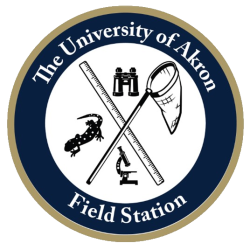Just minutes from the University of Akron campus, Panzner Wetland Wildlife Reserve (PWWR) is a restored wetland system that provides vital ecosystem services to nearby urban areas by purifying water, controlling floods, and supporting wildlife. This large and high quality wetland provides excellent opportunities to explore the value of wetlands and the influence of ecological connections for urban life.

Steve and Jerry Panzner donated the PWWR to the University of Akron in 2012, with the goal of improving the connection between people and the land through outreach, education, and research.
Restoration
The Panzner Brothers restored their 104 acre muck farm to establish one of the top wetland mitigation sites in Ohio. Farmed for 80 years and only minutes from downtown Akron, the project required extensive excavation of soil and plugging or removing of miles of drainage tile. Uncommon among mitigation banks, this project was designed and implemented by the Panzner brothers, rather than a large corporation. They adapted agricultural know-how to develop methods to ‘farm wetlands.’ Because of their vigorous stewardship, within 5 years the entire property achieved Category II and III wetland status status, with nesting ospreys and a thriving mix of vegetation types. In 2009 the Panzners invited local elementary school students to embark on a year-long wetland project that gained local prominence.
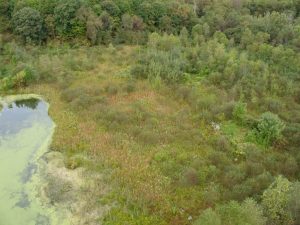
The restorations began in Fall 1999, and returned the parcel to mixed emergent marsh, Sedge-Juncus meadow, forested wetlands, open water, scrub-shrub, and fen habitats. These are similar to the habitats that existed on site before 1921, when this area, once the core of the extensive ‘Copley Swamp’ was converted to farmland. When farmed, the brothers actually had to pump over a million gallons of water a day off the fields because of the extensive groundwater supply in the area
The Panzner Brothers personally conducted all steps in the restoration process, including planning, execution, administration, and management. Their work has established a new and high standard for mitigation banks in Ohio (http://www.epa.ohio.gov/dsw/wetlands/WetlandBankRepor). This project has substantially improved water management and expanded wildlife habitat in the area, and is serving as a model for future restorations.
The Panzner brothers cooperated with Scientists from the beginning of their work, providing many opportunities for graduate and undergraduate students, and facilitating one published scientific paper to date (Hausman et al. 2007. Plant community establishment in a restored wetland: Effects of soil removal. Applied Vegetation Science 10(3): 383-390).
K-12 Education
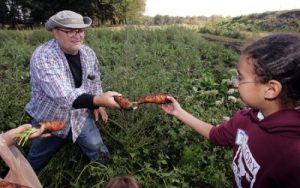
Even before donating the property to UA, the Panzner brothers developed a relationship with Akron Public Schools and began working with faculty and administrators at a new public middle school, the National Inventors Hall of Fame School ‐ Center for Science Technology Engineering and Mathematics Learning, which opened in Fall 2009 (http://www.akronschools.com/scienceschool/). The Panzner’s invited 5th and 6th grade learners from the STEM school to use their restoration as a focus for a year-long, school-wide investigation of wetlands and their value. This provided an ideal opportunity for students to connect the science content that they were learning in the classroom to the real world. The teachers
worked with science, engineering, and education faculty from the University of Akron to design problem‐based lessons to engage students with local water quality issues, while learning Ohio’s science content standards. For example, fifth grade students created “eco-columns” in the classroom before visiting the wetland and discussing soil functions, food webs, biological diversity, and ecosystem functions with the Panzners. This innovative partnership between the Panzner brothers, Akron Public Schools, and the University of Akron was wildly successful and was also profiled in a multi-part series in the Akron Beacon Journal Newspaper (see attachments). The students led a public “Celebration of Learning” in December of 2009, where they taught parents and the community what they discovered with the help of the Panzner brothers. The fifth grade students presented a copy of the wetland field guide that they created to Mr. Steve Panzner, which included descriptions and photos of invertebrates, birds, plants, and the importance of a healthy riparian wetland ecosystem. Hundreds of students learned about wetlands and got hands-on experience during field trips, and thousands of members of the local community shared in this learning through the newspaper articles.
The Akron Beacon-Journal published a 5-part series (http://www.ohio.com/news/making-it-their-own-1.103880) about the STEM (Science, Technology, Engineering, Math) middle school project at Panzner wetland, explaining how the students participated in an evaluation of the property and the ecosystem benefits provided by wetlands. The individual entries of the series can be read at these web addresses:
Part 1 From a seed a stem grows (Dec 27 2009):
http://www.ohio.com/blogs/education/first-bell-on-education-1.286050/from-a-seed-a-stem-grows-1.286275
Part 2 Swamped with ideas (Dec 28 2009) http://www.ohio.com/news/swamped-with-ideas-1.103564
Part 3 Call sends pupils into action (December 29 2009):
http://www.ohio.com/news/ua-biologist-gives-akron-middle-school-tools-to-start-first-hands-on-mission-1.103696
Part 4 Nature of Learning (Dec 30 2009): http://www.ohio.com/news/nature-of-learning-1.103835
Part 5 Making it their own (Dec 31 2009): http://www.ohio.com/news/making-it-their-own-1.103880
In recognition of their efforts, the Panzner brothers received the National Wetlands Awards for Education and Outreach (http://elinwa.org/awards/recipients/steve-and-jerry-panzner) and were honored in a ceremony at the US Botanic Garden.
This engagement with K-12 students continues today. In Fall 2014 PWWR, UAFS,, and the Panzners hosted over 150 middle schoolers from nearby Buchtel Learning Community. These students explored the wetland, made measurements, and in November 2014 gave presentations to UA Faculty and the public about their findings.
University Education Activities
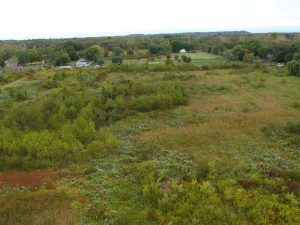
Dozens of UA classes already visit and use the several Field Station properties, as do the many students conducting their independent research projects. Improvements in facilities, transportation, and personnel expand and enhance this experience, and also increase research activity and hands-on study, which are the core of undergraduate education. Expansion of a network of high-tech sensors allows students throughout the University to gather data.
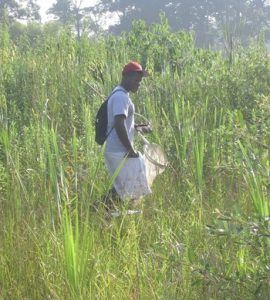
Data generated and communicated through computer-based technologies enhance student’s personal knowledge through coursework and projects, and also allow students to meaningfully participate in generating new scientific knowledge through research collaboration without requiring expensive and numerous visits to the field sites. This experiential learning, inherent to the Life at the Urban-Rural Interface program, aids the Akron Experience initiative directly and is well suited to become part of UA’s proposed enhanced transcript.
The Panzner Brothers are passionate about the educational value of PWWR and have continued as advisors of activities at PWWR.
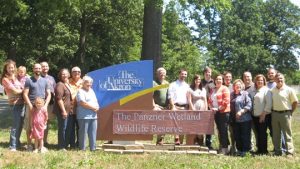
Donation to the University of Akron article
Copley wetland created by two brothers goes to UA. Jan 11 2012. Akron Beacon Journal. http://www.ohio.com/news/local/copley-wetland-created-by-two-brothers-goes-to-ua-1.254545
Selected other publications about Panzner Wetland Wildlife Reserve
2006 Ohio EPA report on the state’s mitigation banks, which found Panzner wetlands to be one of the most successful mitigation banks in Ohio (pg 20; this study included all mitigation banks in the state at that time).
Mack, J.J and M. Micacchion. 2006. An ecological assessment of Ohio mitigation banks: Vegetation, Amphibians, Hydrology, and Soils.
Ohio EPA Technical Report WET/2006-1. Ohio Environmental Protection Agency, Division of Surface Water, Wetland Ecology Group, Columbus, Ohio. This 114 page document can be downloaded from the website of the Ohio EPA, Division of Surface Water http://www.epa.ohio.gov/dsw/wetlands/WetlandBankReport. aspx
